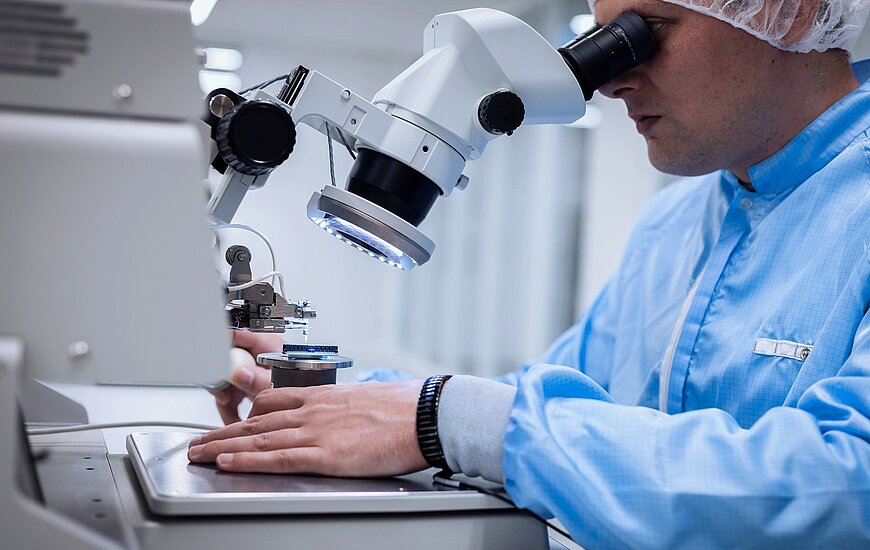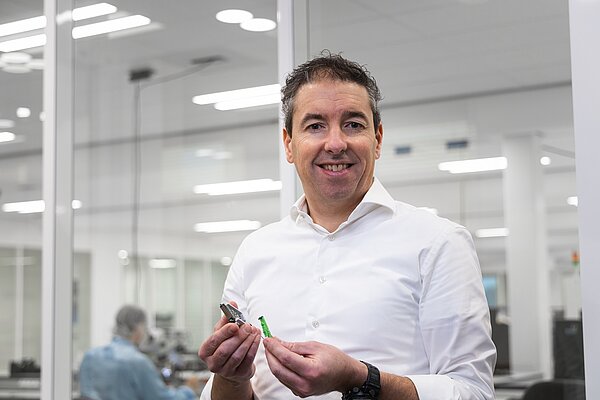Photonfirst ready to claim world leadership in integrated photonic sensing
Photonfirst is looking to become the world’s innovation leader in integrated photonic sensing. It’s just a matter of reaching the stepping stones that will take its technology to high-volume sales. With a few dozen of potential applications in six different markets, the Alkmaar-based company is quickly closing in on a pivot point.

On 1 January, the integrated photonic sensing business unit of instrumentation specialist Technobis was spun out as an independent company called Photonfirst. After fifteen years of lovingly nursing the technology to maturity, the time had come for the bird to leave the nest. However, it’s not quite ready to stand on its own two feet yet: it’s going to take another few years to scale the business in scope and size.
“Our technology to measure temperature, pressure, acceleration, strain or shape deformation has already proven itself in some eye-catching applications, such as the overheat detection system for Airbus 350 planes. Or the sensors that measure the sway of the Taipei 101 skyscraper, which some time ago was the world’s tallest building,” says Photonfirst CEO Daan Kersten. “Now, we need to move into killer applications that generate high-volume sales. But engineering a technology into cost-effective end-to-end solutions takes time.”
Interestingly, Photonfirst hasn’t identified one but several of such potential killer applications and is exploring them in parallel. Testament to the versatility of its light-based sensor technology, the company is targeting no less than six markets: aerospace, energy, high-tech systems, infrastructure, medical and mobility. “We’d love to focus on a single application, but since we don’t know which one will be the first to take off, we can’t afford to put all our eggs in one basket,” Kersten explains.
All companies looking to introduce a new technology have to go through this difficult phase of finding traction in a market, but it may be a little harder for Photonfirst. After all, integrated photonics has only recently grown beyond the demonstration level, and few companies are aware of its potential, let alone possess the in-house knowledge to apply it.
Fortunately, Photonfirst can count on the help of PhotonDelta, a Dutch organization tasked to accelerate the integrated photonics industry. Photondelta actively promotes the adoption of this disruptive technology and has successfully created an ecosystem that’s able to design, develop and produce innovative solutions based on integrated photonic technology. Photonfirst is a front-runner within this ecosystem, but we’ll know more in 2025, the year the Alkmaar-based company aims to generate sales exceeding 100 million euros, go public and become the global innovation leader in integrated photonic sensing.
Inert
Photonfirst’s sensor systems are based on optical fibers inscribed with microstructures called fiber Bragg gratings (FBGs), which partially reflect light traveling through the fiber. As the fiber is subjected to strain, a temperature change or another external influence, the wavelength of the reflected light changes proportionally. By measuring this shift, the strain or temperature change can be quantified.
The devices that detect the wavelength change, so-called interrogators, are usually based on optical spectrometry. Spectrophotometers measure light intensity as a function of wavelength over a certain range. Normally, these instruments are rather bulky, expensive and power-hungry. That’s why Photonfirst has ‘shrunk’ a spectrophotometer to fit on an optical chip – or photonic integrated circuit (PIC), as they’re formally called. This mass-producible PIC is not only much cheaper, smaller and more energy-efficient than regular spectrophotometers, it also features better performance in terms of resolution and accuracy.

Taken together, FBG optical fibers and PIC interrogators make for a powerful duo. “You can fit a lot of FBGs in a fiber, allowing the system to cover large areas with ease. Optic fibers are durable, maintenance-free, lightweight, chemically inert, and don’t experience electromagnetic interference. The system as a whole scales very well to high-volume production, and when you do, costs drop dramatically,” lists Kersten.
Heartbeat
Given these features, it’s no wonder Photonfirst is eyeing so many different markets. In aerospace, the system can be employed for load sensing of landing gear, adding virtually no weight or additional safety risks. By keeping track of the strain experienced by the landing gear over time, it can be assessed when maintenance is required. In extreme cases, a catastrophic failure may be prevented. Similarly, a mesh of FBG measuring points can monitor the structural integrity of the airplane’s wings. Or of wind turbine blades. Or of bridges.
In electric cars, the fibers could be used to extend the driving range by measuring the temperature distribution in the battery pack, allowing for optimization – batteries operate most efficiently at a certain temperature. Car manufacturers will be hard-pressed to find a solution that would take up less space and use less power.
In the medical domain, Photonfirst’s technology can be used to keep track of a patient’s temperature while being subjected to an MRI scan. Obviously, any electrical temperature sensor would fail in this environment of high electromagnetic radiation. And since the heart generates a lot of electric interference too, the fiber-based sensors are ideal to use in cardiac surgery tools, for example as force transducers.
In minimally invasive surgeries, the instruments are delivered to the affected area via hollow tubes inserted through a small incision in the skin. While limiting damage and thus speeding up recovery, a disadvantage of this technique is that the surgeon isn’t in direct contact with the tissue he’s manipulating. Photonfirst’s fibers, embedded in pincher instruments, can be used to measure the tightness of the grip and translated into haptic feedback on the handle of the tool. “We found that doctors could actually feel the heartbeat in a blood vessel,” Kersten says.
Coherent
This is just a small selection of applications that Photonfirst, together with potential customers, has explored already. “It’s amazing how many applications have been thought of over the past fifteen years. At least dozens. We’ve worked with many companies to demonstrate our capabilities, but it takes quite some time before such demonstration projects move up from the research domain onto product roadmaps. Basically, we’re driving for that to happen. At our end, everything is ready to make that next step.”
“In a way, the disruptive nature of our technology is a disadvantage. For example, the telecom sector is already very familiar with light-based technology. Introducing integrated photonics there can be as easy as swapping one component for another. Our technology, based on a principle that hasn’t been commercially applied yet, requires more effort to integrate in existing products.”
Kersten is glad his company doesn’t stand alone in getting the integrated-photonics market off the ground. Photonfirst has partnered up with other companies, which together cover the entire integrated-photonics value chain, to form the PhotonDelta ecosystem. The PhotonDelta office in Eindhoven fosters collaboration, promotes the technology and provides financing, among other things.
“PhotonDelta has been doing a great job increasing awareness about integrated photonics in various end-markets. It has also been advantageous for our company to be able to present ourselves as a part of a world-leading ecosystem. This inspires confidence with potential customers because they’re aware the success of a company depends on the supply chain it’s part of. In Photonfirst’s case: we do almost everything in-house, ranging from R&D to test & assembly, except for manufacturing the PIC. Among others, this is produced by Smart Photonics in Eindhoven, which is obviously a very strategic partner for us.”
“If Photonfirst scales up, then Smart Photonics needs to be able to accommodate that. There are many interdependencies like this in the ecosystem. That’s why it’s very important for the value chain to develop coherently. PhotonDelta guides this process, for example by making sure all companies receive adequate funding. If only certain companies would succeed in finding funding, the roll-out of integrated-photonics technology would be severely hampered. Ultimately, we need each other to succeed.”
Source: Bits&Chips